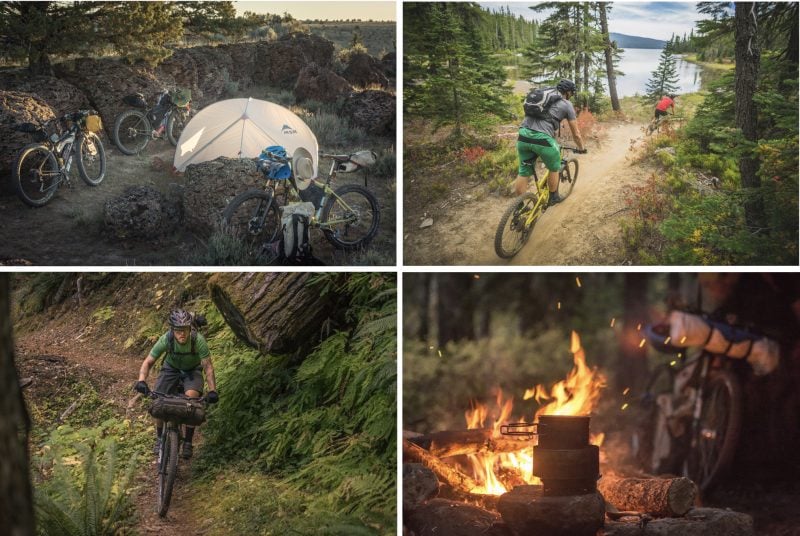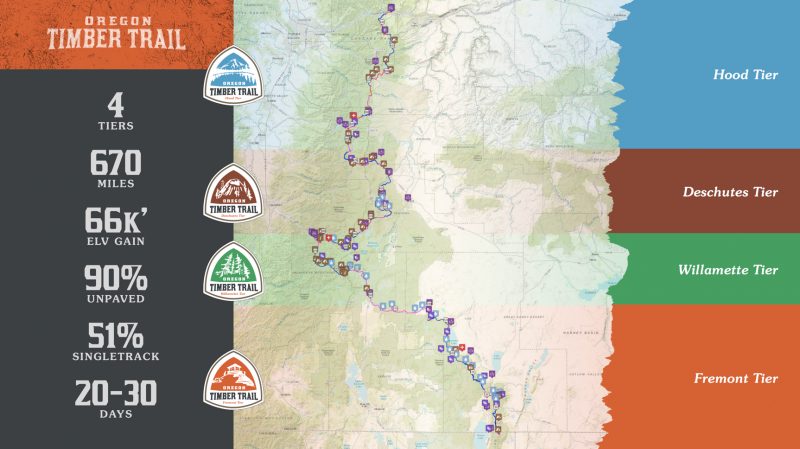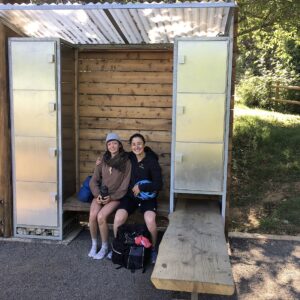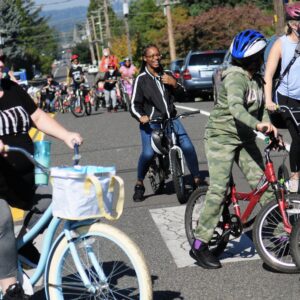
At long last the Oregon Timber Trail is open for business.
After a soft-launch back in March, the 668-mile backcountry mountain bike route is now fully mapped and all the resources you need to research and plan your trip can be found on the official website.
For the past 18 months the people behind this amazing undertaking have worked tirelessly to bring this to fruition. They’ve developed relationship with locals and land managers, logged nearly 1,000 volunteer hours (in June alone!) and 13 days of trail maintenance so far this year, worked with eighth-graders on a cultural and natural history guide, developed a comprehensive route guide, and much more.
The result is something very special. “A world-class bikepacking destination and North America’s premiere long-distance mountain bike route.”
The route consists of four tiers that can be done by themselves or strung together for a bigger adventure. Think of it as the Pacific Crest Trail, but designed specifically for mountain biking with over 90 percent of the the route unpaved and half the mileage consisting of singletrack.
Advertisement
Here’s more from and OTT press release:
Riders depart from the California border, just outside of Lakeview, the highest town in Oregon. Within the first ten miles, riders will crest 8,000 and view the ride north. Ahead, the Fremont Tier is 190+ miles long, followed by the Willamette Tier at 140+ miles, then the 110+ mile Deschutes Tier, and finally the Hood Tier at 200+ miles. Dip your tires in the Columbia River, lay in the grass, and raise a toast to yourself — you just rode a mountain bike across the state of Oregon.
(Now wipe the drool from your desk.)
If you’d like to go deeper into this project and volunteer check out the upcoming Trail Stewardship Campout coming August 25-27th. At this event you’ll be able to work and ride on the trails while camping with friends old and new.
What are you waiting for?! Get over to the website and start planning your adventure today.
And don’t forget to follow the latest updates from the Oregon Timber Trail Alliance crew via Instagram and Facebook.
— Jonathan Maus: (503) 706-8804, @jonathan_maus on Twitter and jonathan@bikeportland.org
BikePortland is supported by the community (that means you!). Please become a subscriber or an advertiser today.







Thanks for reading.
BikePortland has served this community with independent community journalism since 2005. We rely on subscriptions from readers like you to survive. Your financial support is vital in keeping this valuable resource alive and well.
Please subscribe today to strengthen and expand our work.
This looks amazing! I am probably not the only one that’s been poring over the maps. If you ride it as written, it is definitely pretty burly – there are some stretches of 3-4 days between water sources. However, I’ve taken a close look at Google Maps, and it looks like it would be possible to get a car down a Forest Service road for resupply on some of those long stretches in between fixed food / water sources.
So, while it is “cheating” and maybe not entirely in the (very hardcore) spirit of the enterprise, I could definitely see riding this as a group of 4, with one person driving a resupply wagon, and alternating days.
It does look like a ton of fun.
“Riders depart from the California border”
In light of recent conversations here about the penchant for (and irony of) driving to go mountain biking I’m a little surprised that this effort doesn’t anticipate starting from a population center, like Eugene(?) Your recent trip to Hood River being just a fresh example of how one can have lots of fun and excitement on a mountain bike, self-supported. I realize that the trip is laid out along a very thinly populated stretch of our state, which of course follows. But I would think some clever people could conceive of a version that skipped the need for tons of driving. Or?
Or Chemult (an Amtrak Coast Starlight stop much closer to this route)…
Does Brompton make a mountain bike?
Best car-free option to ride as much of the trail as possible would be to take Amtrak to Klamath Falls (which does have baggage service), then intercept the trail via a long paved ride on the OC&E Woods Line. This misses some real Great Basin awesomeness between Silver Lake and Lakeview, but is at least doable.
I’ve already done most of the stuff in the Pacific NW that would be on my bucket list, but one more entry would be to do this trail in multiple chunks, not all at once. Using bus and/or train to get to the trail.
– Hood River (bus 2x/week from Portland) to Government Camp (Mt. Hood Express/SAM).
– Hood River to Detroit, then exit via Gates on Salem Cherriots transit.
– Gates/Detroit to Sisters/Bend (several transit options, but requiring bike to be boxed).
– Sisters/Bend to Chemult – no Amtrak baggage service, but the High Desert POINT bus can get you to Bend.
– Chemult to Silver Lake, returning to K Falls via OC&EWL.
– Final section would involve riding from K Falls out to Silver Lake via the OC&EWL, then doing the final segment to Lakeview as an out and back. It is most likely possible to charter a plane to Lakeview, though I’m guessing mountain bikes may not fit well in most small planes. Needless to say it’s wouldn’t be cheap.
It would be great if people in Washington state eventually picked up the gauntlet and got together to do something similar up there. The routing is a little trickier due to the way the wilderness areas are mapped out – north of White Pass, it pretty much needs to stay east of the Cascade crest, but not like that’s a bad thing.
Still very doable without too terribly much pavement except a stretch over White Pass. Maybe less singletrack, but then again I never would have imagined the Oregon route would be able to take in as much singletrack as it does. I think there are some good chunks of singletrack in the Gifford Pinchot, both sides of Ellensburg and both sides of Winthrop that could be incorporated into the route. The Washington route I’ve mapped out in my head is roughly Bingen-Trout Lake-White Pass-Ellensburg/Cle Elum-Leavenworth-Winthrop-Oroville.
That’s what I’ve been trying to tell you. You can stick to trains and public transport if you want, but they cover essentially NONE of the wild places in the west. For total freedom to access the best hiking and biking, take a car to the trailhead. Of course on a one-way route, you’ll need another driver to move the car.
Most folks have limited time off to get to a trailhead so being able to drive directly to it in a motor vehicle is essential. Doesn’t mean it has to be a gas guzzler and it doesn’t mean you can’t do your daily commute by bike/MAX/bus/foot, but when you have one or 2 weeks off and want to hike in the Wind Rivers, or the Tetons, or the Sawtooths, or the High Uintahs, or the North Cascades, or Banff, or Jasper, etc………you’ll need a way to get there in a hurry.
It is true that you could take a train or bus to within 1 or 200 miles of most of these places, but then you have to get on that bike and hump it thru 100 degree summer heat to get to the trailhead – something few would be willing to do.
You wouldn’t have done too well with mules on the Oregon Trail.
Taking Amtrak to K-falls is going to be a lot faster than:
1. Driving to the Gorge and leaving a car.
2. Driving to the southern Oregon border to unload bikes.
3. After the ride, shuttling back to the southern Oregon border to retrieve the car.
4. Driving back to Portland.
Sometimes, public transit + biking can save time.
Your point is valid for most day trips and loop trips. Circuit trips are a unique beast.
The guide tells you to take Amtrak.
From page 10:
Excellent. I hadn’t found that.
One wonders how much pressure Travel Oregon et al. have or could exert on Amtrak to (a) persuade them to stop in Oakridge and/or (b) adjust the parameters at Chemult so that bikes could be offloaded there?
It is very unlikely to happen if no one asks—or if brushed off—demands that it be done.
Are you not allowed to ride the trail north to south?
Take a bus or ride out to Hood River, and take off. Ride bike or hitch a ride to nearest train station on the south end.
Sure. I thought of that too. Lots of ways to approach this as a potential rider. My point of departure was the pull quote from the promoters that has everyone starting at a remote location on the CA border. It is important I think to hold those organizing these sorts of endeavors accountable for thinking this sort of problem through, not losing sight of the larger implications of what we’re engaging in.
All Oakridge would need is a train station, for those 2-3 passengers per week.
Or you could take one of the buses from Eugene, or ride the 35 miles.
Unfortunately, as I understand it, there is no baggage service at Chemult. Carry ons only.
It would be really nice if Amtrak would stop in Oakridge. How cool would that be?
There is a bus from Eugene to Oakridge (Diamond Express) that runs Mon-Fri ($5). Also, LTD bus 91 in Eugene goes to McKenzie Bridge, at the bottom of McKenzie River Trail. All buses have racks for 3 bikes. In addition to Amtrak, there is a bus to Klamath Falls with bike racks, but it runs from coast through Medford. It’s not that difficult to bike from Kfalls to start of OTT…if you can bike the entire OTT, then those miles shouldn’t matter.
This is such fun – the depth of knowledge all you rural Oregon transit sleuths are sharing. Thanks so much!
Did you know that ODOT operates a statewide network of intrerurban bus routes?
http://oregon-point.com/
Yes. And I’ve taken my bike on their buses (or rather put it underneath). There are various bus systems around the state that work more or less well together. Some counties operate good systems and coordinate with the adjacent counties and some do not.
You would need an extra week away from work to accomplish this endeavor without the proper vehicle. Time…anyone have any extra time to give away?
True, and you don’t even need to own the vehicle. Rent it. BUT, many rental contracts don’t allow you to drive on dirt roads, etc, so be careful. And gotta have insurance – if you have your own car insurance, but don’t for some reason want to drive it (maybe it’s electric and doesn’t have the range), then see if your insurance agent will add on a provision to cover you when driving unowned vehicles (rentals, other people’s vehicles, etc). I have that and it’s cheap.
Rent a vehicle … and then what? Leave your brand-new crime target – er, rental car – parked at the trailhead for 3 weeks? That’s a pretty expensive – and risky – option, especially if you’re riding point to point. Even if you do return to where you parked, there’s some big risk in leaving a vehicle out in the wilds for an extended period. Heaven knows I’ve returned from a tour with a buddy only to find his truck vandalized.
What I have found to reduce this risk is that small town PDs, visitors bureaus or public lands offices will often let you leave a car for a few days in their lot where they can keep an eye on it, if you ask. I have done this in both Burns and Prairie City. People in Lakeview are awfully nice, but then again word will have gotten around Lake County after the debacle of the so-called Outback ride a couple years ago. Anyway, I’d try the Lakeview BLM office first – if you can’t use their lot I’m sure they’ll help you figure out who can help you.
Face it: the logistics of tackling a long distance trail by bike are a hassle no matter how you do it. It’s more difficult than for thru-trail hikers, and it can be plenty frustrating for them. Using transit is not going to take you the extra week that you suggest: the train ride to KF doesn’t take any longer than driving to Lakeview, and from KF it’s less than two days’ riding to the trail in either Silver Lake or Lakeview. If you’re uncomfortable with public transit, fine. By all means, do one of the other alternatives that might (or might not) be slightly less fussy. But some people reading this may decide it is the least-bad option for them.
There are no paper maps or signs for this?
There are maps, a route guide, and a .gpx file available for download at http://www.oregontimbertrail.org
I drove support for the first two riders last year and created maps using CalTopo (caltopo.com) as well as the various adventure maps for a number of more popular areas.
There’s also a bus to Alturas, CA from Redding CA (Amtrak, Greyhound and Airport available), run by Redding Area Bus Authority every Monday, Wednesday and Friday (http://www.cityofredding.org/departments/redding-area-bus-authority/)
On Wednesday there’s a bus from Klamath Falls to Alturas CA from the Amtrak station, and on Tuesday from Redding to Alturas, run by http://sagestage.com/
From Alturas it is only a 5 hours ride to the trail at the border.
Hood River is served by Greyhound most days.
Modoc County, California should plan an extension of this trail to Alturas. It looks like there are dirt and gravel roads that would get you most of the way from there to the border in 2 days, based on Google’s maps, and there may be singletrack that isn’t mapped: https://goo.gl/maps/CCDDW4XjVsL2
A further extension to Burney CA, in Shasta County, would link to daily bus service with a bike rack and 3 buses per day each direction for $5 : http://www.cityofredding.org/departments/redding-area-bus-authority/services/burney-express
24 hours on bike time, approx (for reference only): https://goo.gl/maps/j6wCZnWpz682
had a few friends who just rode Oakridge to Hood River. In their words: “Anyone who thinks this trail is ‘open’ is delusional”. Multiple miles (2-5) long sections of boulder fields requiring bike hauling and GPS location to even stay on ‘route’. This thing still needs a LOT of work…